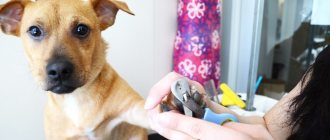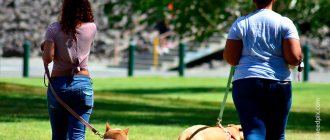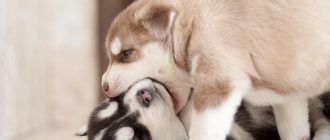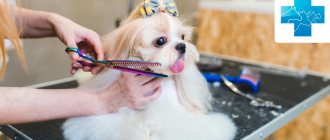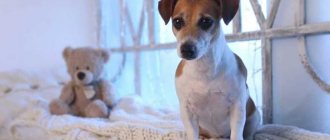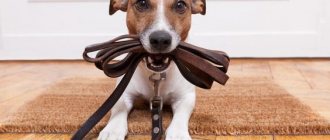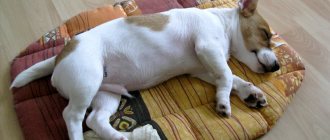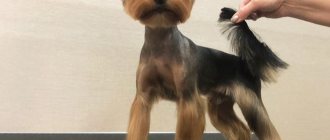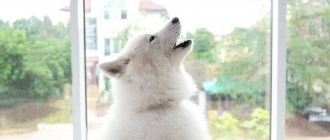Quite often, dog owners encounter problems when trying to trim their animal. Usually a calm and friendly dog reacts sharply to scissors and clippers, spins around and does not let itself be handled, growls and shows its teeth. This behavior is not considered normal and indicates major psychological problems in the puppy.
In most cases, the causes of aggression during grooming lie in childhood. The puppy was simply not trained to this procedure according to all the rules, they were not shown how to behave, or they caused injury through their wrong actions.
An aggressive dog needs to be cut.
Grooming a spaniel has always been a challenge for us too. Especially the paws. I had to take each strand in my hands and slowly cut it off with scissors. Then they cut it with a mechanical clipper, because... The dog could not stand the noise of the vibrations of the electric machine. The paws were clipped only with a muzzle and scissors.
Another tip: let one person do the haircut! And at this time, even if no one comes close, you lock yourself in the room so that you can’t even hear someone else’s presence. It's even better when there's no one in the house. This helped us because... There was no one to stand up for the dog and she had to put up with the fact that she was being cut.
Place it on a high table, and move the table towards the window so that he looks out the window, he will have something to occupy himself with, and you will have something extra. lighting + the dog realizes that he can only jump out the window). As a radical method, there are Velcro strips that can be used to tighten the paws together in pairs. If you put him on his side, he will no longer be able to stand up on his own.
It is better to take breaks while cutting. I used to be able to groom a dog for up to 7 o'clock. And even then not completely. The paws had to be trimmed the next day.
It’s easier now, she has become somewhat deaf. We bought a very powerful machine (45W Moser), which does not heat up and does not chew wool. In 1.5 hours it turns out quickly and smoothly.
And you need to do all this boldly, so that the dog understands that it will have no chance of getting rid of it. And cut regularly to prevent tangles from appearing. At least three times a year.
Only registered users have the ability to start new topics. Register and log in to the site by entering your username and password on the right side of the window, and you can start a new topic.
Before visiting the forum, read the topic: “How to properly consult a veterinarian,” as well as the list of answers to frequently asked questions, this will help you save your time and get an answer to your question faster. Pay special attention to the document: Symptoms of animal diseases. Perhaps in your situation you cannot expect an answer on the forum, but you need to urgently call a doctor or take the animal to a veterinary clinic!
Before joining the forum, read the following sections, this will help save your time and quickly get an answer to your question:
Requirements
According to the requirements of the breed standard, certain evaluation criteria for appearance are established for the Miniature Schnauzer. For exhibition, the dog must be trimmed in the back area, from the back of the head to the croup. The rest of her body can be trimmed.
It is worth considering why trimming is used. The peculiarities of the coat of some dogs, which include the miniature schnauzer, imply faster growth of guard hair with a relatively short and weak down. Since the fur not only forms, but also dies, its abundant retention on the body interferes with the normal formation of a new coat.
The dog looks sloppy and significantly loses its appearance - in comparison with its brothers freed from excess undercoat. The hard awn, due to the lack of shedding, also looks unpresentable and loses its shine and shine.
The multi-layered coat of a miniature schnauzer is associated with the unevenness of its growth. Mature, ripening and young awns remain together on the dog's back and need to be thinned out. When trimming, a special knife is used to pluck out exactly those hairs that are no longer needed. When shearing, the fluff is simply cut off completely, the fur does not look natural, which is very noticeable in the ring. The exhibition length of a Miniature Schnauzer’s “coat” should be no more than 1.5 cm.
When carrying out trimming, it is important to remember to adhere to deadlines. When preparing for an exhibition, the first treatment is carried out no less than 60 days before the show, repeated – 2 weeks
This allows you to achieve the correct length of hair on the back, ensuring the preservation of the aesthetics of the breed within the current standard. Black dogs with a brown undercoat have a higher intensity of hair growth - they need trimming up to 7-8 times a year, every 1.5 months.
Why is this necessary?
In non-shedding and soft-haired breeds, the fur grows throughout its life (like human hair). If it is not cut, the pet will no longer look attractive and will acquire a whole range of problems: tangles, dermatitis resulting from them, scratching, wounds, secondary infections of the skin, parasites. The hair growing in the ears will develop pathogenic microorganisms that cause inflammation and ear disease.
The fur around the eyes and the beard of some breeds should be hygienically trimmed at least once every 2-4 weeks. The paws are also trimmed between the toes, as dirt and debris stuck to it cause discomfort and sometimes pain to the dog. Biological contaminants accumulate around the anus, especially in long-haired dogs, which can smell bad, spoil the dog’s appearance, and cause irritation or inflammation.
Any owner can trim, shorten, and give a hygienic haircut at home. But it is better to entrust exhibition grooming to professionals, at least at first.
What is the grooming procedure?
The concept of groomer originated in 19th century France and meant a person who looked after the appearance of a dog. Then the term “grooming” appeared, which “embraced” the complete procedure for maintaining and improving the appearance of the animal. At the moment, this entire system involves the following dog care activities:
- bathing;
- treating wool and leather with balms, conditioners, lotions;
- removing tangles, thoroughly combing the wool;
- trimming nails;
- cleaning the eye ducts;
- ear cleaning;
- removal of tartar and plaque;
- treating wool with antistatic agents to prevent it from matting;
- wool cutting;
- hair styling before an exhibition or competition.
On a note! Do not confuse daily pet care with professional grooming. The main purpose of the first is hygiene, the main purpose of the second is to maintain an aesthetic appearance. Professional grooming is carried out in special salons by experienced “stylists”. While a hygienic haircut is most often carried out by the owner at home.
Clipped poodle
How to find a good specialist
To become a groomer, you do not need to undergo special training to obtain a certificate or diploma. Many experts have learned the art of dog grooming on their own. The professional skills of groomers can vary greatly, so you need to approach your search for a hairdresser thoroughly.
You can ask your veterinarian for advice on a suitable specialist. Most of them can confidently name a qualified and reliable hairdresser in the nearest area.
This is interesting! It is noteworthy that many veterinary clinics have staff groomers.
When buying a puppy from a breeder, you can ask him if he knows a good dog groomer. In addition, if the breeder is involved in dog shows, he will likely know owners of dogs of that breed and will most likely be able to help you contact them.
Another way to get the information you need is to consult with dog owners living in your neighborhood (if there are any).
Professional groomer at work
If the choice has already been made, then first you should seek advice without a dog. During the conversation, you need to ask the specialist a few open-ended questions, for example, “are there certain breeds that the groomer specializes in caring for.” If among the named breeds the client needs is missing, then it is worth finding another groomer
It is important to pay attention to how the hairdresser treats his clients
One way or another, the main condition is that the person must love dogs, be polite, caring and professional.
What determines the cost of grooming?
The specific cost of the service is determined by several factors:
- level of specialization;
- popularity;
- season (in winter there are fewer clients, so the price for a haircut is reduced);
- work in a private salon or independently (for yourself).
Types of haircuts for dogs
Hairstyles are divided into three groups:
- Hygienic. The hair on the paws, between the toes, on the ears (if drooping), in the groin, inside the ears, and on the muzzle is partially removed. The haircut is also done on the body - the length is arbitrary (at the request of the owner).
- Model. Various haircut options that depend on the hairdresser's imagination. The result is achieved through such techniques as clippervec (shaving areas along the body), flatvec (evening out hair length), blending (makes smooth transitions from one length to another). This haircut may include various additions in the form of braids, ponytails, coloring, and toning.
- Show trim (exhibition). Necessary for participation in competitions of purebred dogs (for example, Yorkie or Poodle), where strict compliance with all canons is important. This haircut is done in salons.
Spitz model haircut
Getting ready for a haircut
In order for the procedure to be safe, successful, and the result to meet your expectations, you need to follow simple rules.
Accustom the dog to the procedure
The most important thing is to teach your pet to calmly endure all manipulations. This needs to start from an early age. You should comb, wash and dry your baby carefully, without causing him discomfort or pain, and be sure to reward him with a treat after the procedure. You can read more about this in the article “Caring for Dog Coat.” So that you can safely use the machine at home, the dog should not be afraid of it. During the game, you can turn on the instrument so that your pet “gets acquainted” with the buzzing object. After several times the animal will stop paying attention to it, and you will be able to use the device for its intended purpose.
Preparation
Before the procedure, take your baby for a walk and feed him so that he can stand quietly for a while and allow the manipulations to be carried out. In advance, just before the haircut, comb your pet well, wash it with a special shampoo with emollients (balm, conditioner), dry it with a hairdryer or let it dry naturally and comb it thoroughly. You cannot cut a shaggy or wet dog - the result may be unpleasantly surprising.
Place and tool
To cut your dog's hair at home, you need to select and prepare a place. It is more convenient to do this on a high, flat surface, such as a table. Workplace lighting plays an important role. You must be able to see clearly what you are doing. Provide access to the table from all sides so that the pet can stand quietly in one place and you can walk around it. Cover the table with a thin rubber or silicone mat that your dog's paws won't slip on.
Prepare a comb - an ordinary thin single-row, preferably metal, and brushes that you use in everyday care. Scissors must be professional, hairdressing, well sharpened. A regular hair clipper won't work either. This should be a special grooming tool. No need to purchase an expensive professional model. A simple animal clipper or scissors will be enough.
Complications after haircut
A dog that is not accustomed to standing still during a haircut, even in the skillful hands of a groomer, can twitch at a crucial moment and provoke a cut or other trouble .
The cut will be treated with an antiseptic, but the aftereffects of other troubles can make themselves felt after some time and scare the owner with the pet’s strange behavior.
There was a case when, after another visit to the salon groomer, a Pekingese couldn’t go “big” for a day - he sat down during a walk, “put his tail” under himself, whined pitifully and looked reproachfully at the owner. The owner's heart was breaking; she did not understand at all what was happening to the dog. Later, experienced “colleagues” suggested that this strange behavior was a reaction to damage in the groin area during haircuts , as well as hair cut too short in the genital area. It took a week of treatment with antiseptics, persuasion and caresses during daily hygiene procedures to remove the consequences of an unsuccessful visit to the salon.
Important: for some dogs, especially males, it is not recommended to shave the hair in the groin area very short, “to zero.”
Similar behavior of the dog - strange sideways jumps, constant squats, a desire to hide - was also described by the owner of a cocker spaniel. Each time after a haircut, the dog needed time to recover.
He didn’t have any pain, he just felt uncomfortable with his hair cut, he was embarrassed and suffered from the “humiliation” he experienced.
But the essence of a proper haircut is precisely that the dog should not experience humiliation and psychological discomfort . And there should be extremely pleasant sensations. And this is achieved in only one way - love for the animal, and with the only message - to do good to him: so that his eyes look, his ears don’t itch, his paws don’t hurt, nothing bothers him anywhere, and they turn around after your dog in admiration: “Ah! What a beautiful girl!"
And kind words, as you know, are pleasant to a dog.
How to properly cut a dog's hair
For professional grooming and for doing your own haircut at home, there are conditions that must be met.
All cuts are made in the direction of hair growth, the tool is held strictly parallel to the surface being treated to avoid injury. The only exception is trimming poodles' paws.
Hygienic haircut
This type of haircut includes treatment of the area around the eyes, muzzle (beard, mustache), ears, groin, armpits, area around the anus, genitals and paws. Large areas – the belly and butt – are easiest to cut using a clipper with a 4-5 mm nozzle. If you use scissors, hold them with the ends down and make short, even vertical cuts. Folds in the skin should be stretched and cut at a sufficient distance from the skin to avoid injury. For long-haired pets, a hygienic haircut is done in such a way that the long outer hair hides the cut areas.
Using small, well-sharpened scissors, carefully trim excess hair around the eyes and remove all hair from the ears. If necessary, you can also shorten the coat on the outside. If you use a clipper, smoothly draw a line from the eyes to the nose, holding the dog tightly by the mouth, but at the same time try to speak gently to him to calm him down. The paws should be combed well and everything that protrudes beyond the pads should be cut off, and the hair between the toes should also be trimmed. But don't try to cut too deep - you could injure your dog.
Hair straightening and shortening
Many dog breeds need to regularly trim their beard and long hair on the sides - this can be done at home with scissors. Try to make cuts in one precise motion, holding the scissors parallel to your body. If it doesn’t work, carefully move from left to right, trying to keep a straight line and without lifting your hands.
The fur on the paws is cut with oblique cuts, holding the scissors vertically, ends down, giving it the desired length and shape. After this, you need to comb the dog and cut off any stray hairs.
Using a machine, using 3-5 mm nozzles, you can remove excess hair from the back and sides. You should move in the direction from the head (base of the neck) to the tail, and on the sides - from top to bottom. Fur on the belly should be removed with extreme caution so as not to injure the nipples and delicate skin in this area. If this is your first experience with a machine, you can carefully trim the hair in the area of the nipples with scissors and then smoothly align the transition line with the machine.
Haircut without problems: techniques and secrets
Dogs that react nervously to the word “haircut” and timidly tuck their tails at the sight of scissors are not uncommon. Unfortunately. And the animal’s dislike for this painless and, in general, pleasant procedure is the owner’s fault.
Dogs need to be taught to groom, comb, and other hygiene procedures from the time , just like to use a leash and collar. To do this, when the puppy is playing, gently stroke his fur with a comb. Repeat this action. A comb should not evoke fear, but only positive emotions.
Important : you need to start accustoming your puppy to grooming from 3 months.
All procedures should be enjoyable and evoke positive emotions for both participants in the process. And then the dog will get used to standing calmly when it is combed, cut, and washed. And he won’t make frightened eyes at the sound of a hair dryer and hair clipper being turned on.
Experts advise
- Grooming a walking dog, in a good mood.
- Groom your dog dry and clean. Wet wool quickly makes scissors dull.
- Grooming a combed dog. This will make the cutting process easier and allow you to do it smoothly and accurately.
- Groom your dog on a table that you can move around freely.
- It is better not to turn the dog around while grooming unless absolutely necessary. This is additional stress for her.
- If there is a large amount of work, divide it into several stages so as not to overtire the dog and not cause him negative emotions from the grooming process.
- No aggression from the owner or sudden movements.
- Start cutting from the ears, paws, and muzzle. The torso is cut last - the scissors (clipper) are guided along the hair growth, parallel to the torso.
- It is more convenient to cut the neck, body, belly and groin with a clipper.
- The paw pads, muzzle and base of the tail are trimmed only with scissors.
- When cutting the muzzle, the scissors go in the direction “away from the eyes”.
- Particular care when cutting requires delicate places - the groin, armpits, base of the tail.
- The first haircut with a clipper should not be “zero” - very short, until your hand is “full”, so as not to injure the animal.
- During the procedure, praise the dog, stroke it, and talk to it. There are known cases when pets immediately stopped trembling on the table as soon as they began to be showered with compliments.
Why trim your dog's nails?
The vast majority of urban four-legged animals spend only a short time on the street. They live most of the day in apartments where slippery parquet, linoleum or soft carpet do not allow the nail plate to wear down to its natural state. Because of this, it grows regularly and problems arise.
Indications for manicure
If the dog does not live on the street, trimming its nails is a mandatory procedure. What are the consequences of not getting a manicure?
Experienced dog breeders recommend that novice owners consult with a veterinarian or groomer before performing any manipulation. A professional will advise what length to leave, suggest an algorithm of actions and even conduct a master class on trimming.
Structure of a dog's claw
It is necessary to understand the anatomy of the paw and claw in order to do a dog manicure without unnecessary trouble.
An animal's claw has a part with blood vessels and nerve endings called the claw bed. If you touch him, the sensation will be equivalent to cutting off a piece of living skin from a dog. Therefore, you can cut only the overgrown and keratinized part - it is clearly visible in the light. If the fur between your toes interferes with your vision, carefully trim that too.
Different dog breeds have different claw shapes:
The cutting principle will remain the same, but tools of different sharpness and shape may be required.
Types of sedatives for grooming
If you have already tried several options and found that yes, your dog definitely needs sedation, you will need to contact your veterinarian or veterinary behaviorist for the most appropriate drug. While deciding what type of drug to use is beyond the scope of this article and should be strictly at your veterinarian's discretion, working alongside veterinary behaviorists and general veterinarians, I would like to point out a few common cases.
How to train a dog to trim its nails
Breeders with many years of experience and veterinarians believe that there is nothing complicated in the procedure itself if the animal has been accustomed to it since childhood. But the process of getting used to manicure becomes a difficult ordeal for most, so it’s worth preparing in advance and knowing what awaits you and your pet.
You need to get down to business in a state of calm. The dog will instantly feel nervous excitement, stress or anger of the owner and will also experience unpleasant sensations. The pet will not understand the reason for such feelings, but will begin to worry, twitch, and break free from the person’s hands. This will significantly complicate the procedure.
You should introduce your pet to the grooming procedure without haste. When the four-legged animal is in a calm, even relaxed state (after a walk and food), you should lift its paw, try it on and cut off a small tip - as if conducting a test. You should not force the animal or do it with effort and fuss. After the first success, you need to praise your pet: treat it with a tasty piece, scratch it, hug it. Having worked and consolidated the positive sensations, you can move on to the next claw.
If the dog has already had a negative experience with a manicure, then the situation will be much more complicated. Your four-legged friend will begin to get nervous just at the sight of tools, will not want to give you a paw, and may run away and hide. Then the algorithm of actions will be as follows:
At the very beginning, the process takes quite a lot of time. Sometimes it takes a whole day to finish one nail. But as soon as your four-legged friend gets used to the process, you can do everything at once.
Acepromazine
After unsuccessful attempts with Benadryl or melatonin, some veterinarians recommend Acepromazine. Now, this is a much more potent drug, but with higher potency there is an increased chance of side effects . This drug can cause what is called a paradoxical reaction, which means that it causes the opposite of what the drug is intended to do. In this case, instead of relieving anxiety, your dog may become hyperactive and even aggressive!
How often do you trim a dog's nails?
It is impossible to answer this question unequivocally: the frequency depends entirely on what kind of life the pet leads. If the dog lives in a comfortable city apartment, walks in a diaper or in a litter box, runs on laminate, parquet, linoleum, carpet, then the nail plate should be trimmed quite often - as it grows.
An active pet that spends a lot of time outdoors, running and playing on hard asphalt, is cut much less often. Thanks to walks, the claws wear down on their own, and the owner only needs to make a small correction.
It’s not difficult to understand that it’s time for a haircut: the pet begins to cling to textiles in the house. Then you need to trim your claws. Another way is to visually assess the condition of the claw, which is what more experienced dog breeders usually do.
Veterinarians remind us that there are blood vessels under the hard surface. The length of the vessels depends on the length of the plate. Therefore, it should not be allowed to grow to an excessive size, otherwise in advanced cases it will become almost impossible to remove part of the claw without damaging the vessel.
Healthy whiskers are a sign of excellent dog health.
You should never trim a dog's whiskers, as damage to them can lead to nervous system disorders and the dog may become lethargic. This condition is not particularly dangerous for the life of the animal, however, it can lead to persistent stressful experiences, as a result of which the dog’s behavior may be inadequate and unpredictable.
It is necessary to clearly understand that a mustache is not even hair, in the usual sense, but rather modified receptors formed during the evolutionary process. If the ordinary hairs that make up an animal's fur perform the function of preserving heat, then the purpose of the whiskers comes down to tactile analysis of the environment. Information about the slightest change in the state of the surrounding world, even a change in atmospheric pressure or air humidity, will be immediately perceived and analyzed by these natural sensors.
The presence of whiskers gives the dog the ability to accurately navigate in space, determine the location of objects and avoid collisions with them, and overcome various obstacles even in the darkest time of day.
Summarizing all of the above, it is worth understanding that dogs’ whiskers are mainly an instrument of smell and tactile touch. The longer the mustache, the more sensitive and receptive it is to the analysis of the information received. It is these devices that enable the pet to form impressions about the world around him, not fragmented and abrupt, but more holistically. Bringing visual composition to conscious perfection.
It is hardly possible to imagine that a loving owner, possessing the above information, would want to deliberately limit his pet’s holistic and conscious perception of the world, depriving him of the opportunity to receive information about a particular subject only because of his own desire to see the dog more beautiful.
In many breeds of dogs, especially those with light coat color, the mustache is often inconspicuous and during a hygienic haircut they may simply not be seen and cut off
Therefore, a hygienic haircut must be carried out with special care and maximum attention, especially in the eye area. If this procedure seems too scrupulous, then you should opt for a procedure such as grooming
Grooming is a haircut of a dog performed by a professional, the purpose of which is the beautiful appearance of the pet (this procedure is especially relevant when preparing the dog for various exhibitions).
Today, thanks to the efforts and aspirations of breeders for beauty, there are entire groups of decorative dogs for which trimming the mustache is a natural and necessary process. The happy owner of a poodle or Pekingese will have to trim his dog's whiskers with some regularity.
The other side of the coin in this case is that the whiskers of such dogs can grow quite long. In addition to the fact that in this form they make the dog unattractive, on top of that they will disturb the dog and get into his eyes. In addition to simple discomfort, this can lead to ulcerative inflammation of the cornea and subsequent deterioration or complete loss of vision.
Having analyzed all the above information, it is worth noting that trimming a dog’s mustache is undesirable, since trimming it can lead to a disorder of the nervous system, and as a result, inferiority of the animal.
Where to cut: at home or at the groomer?
If you regularly get your pet's hair done at a grooming salon or with a specialist, it makes sense to trust the same groomer to do the manicure. You won't have to take your pet anywhere anymore.
If your dog does not require visits to the hairdresser, you can trim its nails at home. It will be cheaper and faster.
Some individuals prefer to behave calmly only with a professional, but with the owner they become uncontrollable. In this case, there is only one way out: take the stubborn dog to the groomer. You can call him to your home - it will be a little more expensive, but it will save time and effort.
If you have never had a dog and you have no idea how to trim a dog’s nails at home, you can go to a salon the first time or two and see how it’s done. And then act independently.
The main reasons for aggression during haircuts
The dog is a fairly intelligent animal with a complex and interesting psychology, so they are never aggressive out of nowhere. There is always a reason for such a change in character.
Most experienced groomers and veterinarians identify three main reasons for inappropriate grooming behavior:
- Fear. This is the most difficult case to correct, since such behavior is formed after a clearly unsuccessful first experience. Most often, it is characteristic of decorative dogs, which were treated extremely carelessly during puppyhood and left severe damage to the skin in previous times. It is very difficult to get used to cutting hair again, to reduce the level of aggression and fidgetiness, and to make it clear that the procedure is safe. This requires enormous patience from the owner and the most comfortable conditions for the dog. Sending a fearful dog to the salon to an experienced groomer means further increasing the discomfort. Masters prefer to work with such clients in a home environment and in the presence of the owner. Ideally, all manipulations should be carried out by the beloved owner, whom the animal most trusts, himself. The procedure for shortening the fur will have to be carried out in parts and gradually, starting from the most distant and safe places, accustoming to the idea that what is happening is not scary and does not bring discomfort. Talk to your pet in a gentle voice, pet him, give him a treat. Do not show aggression under any circumstances. It is quite simple to understand that fear is the basis for strange actions. If the animal is already an adult and instability in behavior manifests itself only at moments when the fur is manipulated, then the roots definitely lie in childhood. You can adjust the course of action in 2-4 sessions, depending on the degree of stubbornness of the dog.
- Nervousness is typical for choleric people, who are active, mobile and very sensitive to the emotions of their owner. Often the cause of aggression is our own emotions. We are nervous, worried, and this is transmitted to our four-legged friend, who understands that something wrong is happening. This can be especially noticeable the first time or when changing technicians. Left alone with a stranger who will manipulate the fur, the dog panics and tries not to let him get close to him. You can correct the situation by carrying out grooming at home with the help of a visiting technician or on your own and using sedatives. A calm, confident voice and gentle hands of the owner can greatly alleviate the situation.
- Trying to dominate. Dominants are the most difficult to care for. The little tyrant simply will not allow you to do grooming at home on your own, since for him, shortening the fur means subduing him. If a pet has become the head of your family, then a professional in the salon will have to do the hairstyle, since in this case he reacts not only to a stranger, with whom the relationship has not yet been built, but also to a new place. This allows the master to look much more confident than a dog and cope with the obstinate one. However, if you are tired of the animal considering itself the leader of the pack, it is still possible to correct the behavior by turning to the services of a dog psychologist. It is easy to recognize that the reason for the manifestation of aggression, showing teeth and fidgetiness lies precisely in dominant inclinations. If a dog doesn’t let you near its bowl, doesn’t respond to commands, doesn’t give away toys, it means it doesn’t consider the owner to be in charge.
The mixed type is the most difficult option. It is necessary to unravel the whole tangle of dog emotions and figure out the reason for such a reaction. Without knowing the history of the dog and its usual character, this is quite difficult. Most often, attempts to dominate are mixed with confusion. In this case, the pet does not know how to react to what is happening and tries to keep away those who, as it believes, are lower on the social ladder. This is a rather dangerous combination, so any manipulation of the fur of such dogs is best done with a collar and carefully secured. If you are not planning long-term therapy with a canine psychologist in the future and your pet’s breed does not require a mandatory haircut, you should avoid this procedure altogether.
If it doesn't give and bites
A small dog can be swaddled in a towel or a small thick blanket. Only one paw and the tip of the muzzle should remain outside. When carrying out the nail trimming procedure, the dog must be held tightly so that it does not break free and fall or run away.
There is also another simple way: take the dog in your arms, turn it over on its back, and cut it calmly; it is not difficult to restrain a struggling dog; on its back, they are practically defenseless and powerless.
Be sure to praise your dog and give him treats! Do a couple of dress rehearsals as well: e.g. Prepare everything for the grooming and let the dog feel the moment and get used to the tools. There is no need to cut your hair the first 2-3 times, just “rehearse.”
Step by step procedure at home
After the preparation has been completed, you can proceed to the main stage. At first everything may seem long, but in reality the procedure flies by.
So, everything in order:
It is better to start a hygienic haircut with the least favorite procedure - trimming nails. Immediately after this, small scissors with rounded tips are used to cut out all excess between the fingers and pads, forming a neat round foot.
The second step is to move to the head. Here the inside of the ears is trimmed, and the muzzle is shaped in accordance with the requirements of the breed.
From the head a smooth transition is made along the neck to the shoulders and body.
The groin is shaved with a clipper; boys are sometimes left with a “curtain” that covers their dignity.
Along the body, the owner leaves the length that he wants, and depending on this, he works with a machine or evens out the bottom line with scissors.
Small feathering is left on the paws or they form columns, like those of poodles. The tail is usually left brushed unless docked.
The last step is to create a top note (“bun” from the bangs), if necessary.
It is very important to tie the elastic bands and ponytails correctly and not to overtighten the ear - part may die and fall off.
The full length of the coat is rarely left during a hygienic haircut: usually it is cut short or a skirt of medium length is left. After the procedure, it is recommended to bathe your pet again to wash away short, prickly hairs and avoid skin irritation.
Additional care - dog pedicure
Dogs' nails need to be cared for throughout the pet's life. This is not about worshiping glamorous fashion, but about a vital necessity. Domestic dogs are losing many of the advantages that nature originally endowed them with many centuries ago:
As a result, dogs' claws become loose, and their structure is often disturbed—proper care will solve the problem. Pedicure accessories will provide the nail plate with an even edge and a smooth surface. You can learn how to do a pedicure yourself, but you shouldn’t forget about professional services.
What you need to have in your arsenal:
When using a grinder, the risk of injury is minimal
Using an electric grinder, you can adjust your claws all year round. Then they do not have time to grow, which means there is no need for a haircut.
An untrained dog is irritated by the vibration and characteristic sound of the device. But this can also be solved. One or two procedures, and the pet will resign itself, making sure there is no reason to worry.
Brands
Today, many companies around the world produce haircutting devices. Devices from Germany and the USA are especially popular. Eastern countries are also engaged in their manufacture, but the models they produce have not been successful among professional craftsmen.
Wahl
Electric Wahl
Leo Wall (USA) invented the first machine while still a student. He later opened in Sterling, where the company's head office is still located.
Already in the 60s of the twentieth century, WAHL presented the first wireless device. And two decades later, the company introduces the first cordless trimmer.
By the end of the twentieth century, it moved to a new level, purchasing the Moser brand and starting supplying its goods to Europe. Until now, WAHL cars are very popular. This brand is preferred in 156 countries around the world.
Moser
Moser
It began in 1946 in the town of Unterkirnach. Its founder was the German engineer Kuno Moser.
Initially, he repaired various types of industrial equipment, but later devoted himself entirely to the creation of hair cutting devices.
He presented the first model of the machine in 1959 under the name “Famos”, which was an abbreviation for “Firma Moser”.
In the 70s, the company was bought by the Ebner family and during this period the company expanded. In the 90s of the last century, a merger between Moser and Wahl took place. Currently, cars under the Moser brand are manufactured not only in Germany, but also in the USA and even in Hungary. It is the Moser models that are extremely popular among domestic animal groomers.
Andis
Andis
At the beginning of the twentieth century, Matthew Andis was a hired worker and was engaged in the production of tools. He later quit, deciding to create his own business. Together with partners, he opened the Andis OM Manufacturing enterprise in 1920.
After the successful debut of his cat and dog clippers, Matthew founded the Andis Clipper Company. At that time, Andis models were characterized by compactness and higher performance. These qualities set the company apart from the rest.
Throughout its existence, the company and the plant were inherited in the Andis family. New managers, as a rule, worked at the enterprise from an early age and themselves proposed new and improved options. Today the company represents its products in 90 countries.
Young brand Ziver
Ziver
Compared to other companies, the Ziver brand stands out for its youth. The company was founded in 2010 in Moscow. Its main direction is the production of products for the care of dogs and other animals. These are not only clippers, but also trimming knives, combs, various brushes, tangle cutters, a furminator and other accessories for pet fur.
Despite its relative youth, the Siver company has confidently occupied its market segment and gained strong popularity among consumers.
The company's factories and branches are located in Russia, Taiwan, South Korea and China. In addition to grooming tools, the Ziver company produces cosmetic devices, toys and even treats for cats and dogs, which are already quite popular in our country.
Codos
Chinese Codos
Shenzhen Codos Electrical Appliances Co., Ltd or Kodos for short was founded in 2004 in China. Models of machines of this brand are produced for specific purposes: for veterinary work, for hygienic haircuts and trimmers.
A special feature of the company is that most of the models are powered by a battery, which needs to be charged for 1-2 hours. In offline mode, the products operate for up to 90 minutes.
This version of the haircut gadget is convenient primarily at the exit. For example, if you often perform at shows with your dog, such a machine should definitely be in your arsenal of tools to quickly correct any shortcomings before the ring.
German Baorun
Baorun
Unfortunately, not much is known about Baorun. This is a German brand whose factory is located in China. For this reason, Baorun cars are actively sold on AliExpress. Models from this company are considered a budget option for pet owners.
The products (like Kodos) work autonomously: they are charged from the mains for up to 4 hours and can work for 60 minutes without interruption and additional recharging.
How to properly trim a dog's nails with a nail clipper
The manipulation of shortening the claw should take place with minimal discomfort for the pet. To prevent the procedure from causing unnecessary anxiety, it is important to know the sequence of actions:
Black claws are considered the most difficult to trim. On beige and light-colored claws, it is easy to see blood vessels, which will greatly facilitate the process. The pulp appears as a darker area.
You can see the approximate location of the pulp with blood vessels on the black claw by the location of the hollow. Sometimes the depression is on the side. Veterinarians advise focusing on the hollow and pruning very carefully, not trying to cut everything off at once.
General anesthesia
In severe cases, the dog may need to be placed under general anesthesia for grooming. Of course, this is done at the veterinarian's office. This is often done in cases of overly fussy dogs, or when there may be pain or a need for the dog to remain still for long periods of time. An upset dog or cat full of painful mats may be better off being placed under itself rather than being forced to remain motionless and in pain for some time.
Different breeds
Using the above tips and recommendations, you can trim the nails of almost any dog, regardless of its breed and size. However, there are breeds in which the process of trimming nails has some peculiarities. All these dogs have one thing in common: they are classified as indoor and decorative dogs and are very small in size. These include the Yorkie, Chihuahua, Miniature Spitz and Toy Terrier.
How to cut hair for small breed dogs?
York
Let's figure out how to properly cut a Yorkie's (Yorkshire terrier) nails. After all, their claws need to be trimmed regularly not only for the sake of beauty, but also to avoid health problems. If the claws grow too long, they can curl up and grow into the pads of the toe.
Chihuahua
A note for those who are interested in how to properly cut a Chihuahua's nails:
IMPORTANT ! You should not forcefully cut your Chihuahua's claws. If the dog gets scared or feels rough treatment, then next time it will be much more difficult to persuade it to undergo this procedure.
Spitz
Like all other dogs, Pomeranians need to have their nails trimmed from time to time. It is better to do this with guillotine-type nail clippers for small dogs.
Before trimming, trim the hair on your dog's toes if necessary.
To carefully trim the claw and avoid touching the pulp, take the Spitz's paw, press on the pad and hold the claw up to the light. This will help determine where the keratinized part ends. If you still can’t see the pulp, then just start cutting about 1 mm at a time until you see a point on the cut. After this, clean the cut with a file.
Toy terrier
Toy puppies begin to trim their claws already at one and a half weeks of age and do this every 15-20 days. Adult dogs of this breed have their nails trimmed every 20-30 days.
It is necessary to trim the toy terrier's nails, if only because due to the small weight of these dogs, their claws do not wear down even while walking on asphalt or gravel, no matter how long the toy walks.
Place the dog on your knees and, taking its paw, pressing on the pad, extend the claw, then cut it off by 3-4 mm. It would be enough.
ATTENTION ! Toy terriers, despite their small stature, are distinguished by rare stubbornness. If you give up ahead of time and let him go until the end of the procedure, then he will not allow you to trim his claws; on the contrary, he will resist even more.
Dachshund
Grinder - an alternative to cutting
Let's start with the advantages:
- The machine can be used to process animal claws of any size. However, the nozzles must be individual.
- The machine copes with claws of any thickness and hardness.
- When grinding there is no risk of crushing the claw.
- There are no burrs, cracks or other damage left on the claw.
- By grinding, you can not only shorten, but also polish the nails so that the dog does not cling to the bedding or other surfaces.
- Does not make sharp sounds - the cause of panic in most dogs who are afraid to cut their nails.
The next step is to develop an action plan. Keep in mind that training a dog with a phobia is a long process and you will have to work with your dog's comfort and stress levels.
Step #1: The first part of the process involves getting your dog used to having their nails handled. There is no need to use any special tools at this stage. When touching the dog's paws, run your hand over the claws and fingers. When the pet begins to calmly relate to these manipulations, you need to start gently tapping the claws with something safe (pencil, spoon, etc.). Every time the dog reacts calmly or interestedly, praise it. Any signs of stress at this stage should be taken into account immediately. If the dog develops negative associations in the first step, the rest of the process is useless.
Step #2: Introduce your dog to the sander, but don't turn it on. Let the machine be in a visible place so that your pet can inspect it. Repeat step one, but try touching the dog's nails with the clipper turned off. If your pet reacts calmly, move on to the next step.
Step No. 3. Turn on the machine in the next room, leave it on the table and approach the dog. Watch the reaction, if the dog is calm, move the machine closer and turn it on again. Start with low speeds so that your pet is not afraid of the “hum.” Let your pet rest and repeat step two - touch the nail file to the nails while the clipper is turned off. Afterwards, remove the machine from the claw and start it at low speeds. Calm and praise your pet constantly! After 1-2 weeks, the dog will understand that you will not harm him. From now on, you can start treating your dog's claws, but no more than one per day.
First aid for injuries
Despite full compliance with the rules and compliance with the operating algorithm, even an experienced owner can make a mistake. This can be caused by various circumstances: a sharp sound outside the window, a dull nail clipper, or excessive nervousness of the pet. Don't get upset - it's important to remain calm, apologize to the dog and treat the wound.
Pulp cut
Trimming too short greatly increases the risk of damaging blood vessels. This causes severe pain and excessive bleeding. The main task of the owner in case of pulp injury is to urgently stop the bleeding. In addition, it is necessary to calm your four-legged friend - his reaction will be panic and a desire to run away.
The owner should try to distract the animal, switch its attention to something else - perhaps to a toy or a pre-prepared treat. There is no point in screaming at this moment, as the dog is already scared and in pain. Next you need to treat the wound with hydrogen peroxide. It is not recommended to use alcohol-based solutions - they will only increase the pain and cause a burning sensation.
Antiseptic powder has a good effect. Veterinarians advise having this drug in your pet first aid kit. It is used to treat open wounds and abrasions and copes well with injuries caused during trimming of the nail plate.
Claw detonation
A similar nuisance arises in the case of nervous and uncertain actions of the dog breeder. The dangerous combination of slow compression of the nail cutter along with an unexpected and sharp jerk of the limb during shortening leads to a poor result. Damage to the skin and soft tissues is accompanied by severe pain and fear, and not only from the dog - the owner also experiences nervous shock. However, you should gather your strength and provide first aid to the victim:
When transporting an animal to a veterinary clinic, cold should be applied to the damaged area, but at the same time avoid frostbite of the limb.
Source
Treatment of wounds
Make sure your dog does not develop open wounds as a result of your actions. If any of the claws begin to bleed, do not let the dog run away from you and lick the wounds into a dark corner. You need to treat and disinfect the injured area.
Hydrogen peroxide will prevent infections from entering the wound on the paw
Apply a hemostatic agent to the damaged area. During the procedure, do not let go of the animal's paws. Soak a cotton pad in hydrogen peroxide or chlorhexidine and apply to the damaged area. Sit in a fixed position with your dog for a few minutes.
Be sure to comfort the animal and let it know that there will be no more discomfort from the procedure. Make sure that during this time the animal does not come into contact with the street and does not lick its claws.
By licking wounds on the paws, a dog risks introducing dangerous bacteria into them.
Vegans, enlightenment and a tea bag
My colleague hung up. After talking with the guest from room 815, Renat looked very surprised. -Alex, they are asking for a senior about a tea bag. -What?
We looked at each other and started laughing, remembering the Nigerian film “Awesome Transport”.
The time was approaching two o'clock in the morning and smoking guests periodically scurried through the silence of the first floor hall, past the reception desk. Someone was shuffling along the marble in white fluffy slippers, not wanting to change into street shoes. The automatic door of the central entrance began to rotate, letting the courier through. A young man with a package came up to us and lowered his load onto the counter. -Good evening, food delivery to room 815 for Lisa. They asked to leave it at the reception. -We do not deliver parcels or food products. Call the customer, they should meet you.
Muttering something similar to “dapoh,” the boy left. Renat and I looked at each other and decided to hell with him. You still have to get up at the guest’s request. Having decided that since there is nothing to do, we will go together and speed up the process. Perhaps the woman needs to replenish the supply of tea bags in her room. I grabbed the bag with the boxes of food and we headed to the elevator. Renat went to the housekeeping warehouse to get tea and a couple of bottles of water for the guest, and I went to her room. Stopping in front of the door, I straightened my tie and knocked. -Good night, receptionist. You asked me to come over... -Yes, I did! This is barbarism and disgrace!
The disgrace is that I again observe a pretty woman in lingerie while working. Slender body, hieroglyph tattoos. Tunnels in the ears. Maybe some kind of obsessed with the East or yoga? The mantra “om namah shivaya” was heard from a portable speaker in the room.
-My name is Alex. Elizabeth, I would like to clarify what you consider barbarism and disgrace? -Tea station! You have tea bags from manufacturers who use plastic raw materials. I can't drink this. Along with natural fibers, the tea bag also contains plastic fibers! True, there are also bags made from natural raw materials, but here the thread is glued to the bag, and not attached with a paper clip! And they use glue containing casein. Right now, for a month, I have not consumed animal products. Therefore, this is not acceptable for me, and a hotel of your level does not offer an alternative.
All this time, she continued to shake a wet bag of green tea, which I did not immediately notice. Damn vegans. Renat peeked out from behind me, rustling tea bags. After a short “oh them.. Hello,” he froze.
-The courier handed over the order to you, we usually don’t deliver it, but as an exception to the rule. It is for you. In the future, you will need to go down and meet him. As for tea, I can offer you brewed tea from the room service menu, at the establishment’s expense. Please choose what you need and we will deliver a supply of tea leaves and a teapot to your room.
With the words “thank you, savages,” she put a wet tea bag in Renata’s palm and closed the door. We looked at each other and walked towards the elevator. Suddenly, the door behind me opened again. We turned around. Our friend walked towards us with a confident step. There was determination on his face. She was holding a delivery box in her hands. After a couple of seconds, she shook it out in front of me. I looked at my shoes covered in rice and some shrimp.

